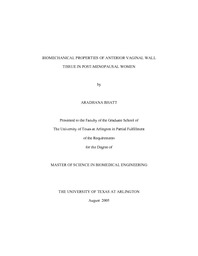| dc.contributor.author | Bhatt, Aradhana | en_US |
| dc.date.accessioned | 2007-08-23T01:56:25Z | |
| dc.date.available | 2007-08-23T01:56:25Z | |
| dc.date.issued | 2007-08-23T01:56:25Z | |
| dc.date.submitted | August 2005 | en_US |
| dc.identifier.other | DISS-1023 | en_US |
| dc.identifier.uri | http://hdl.handle.net/10106/281 | |
| dc.description.abstract | Cystocele repair in post-menopausal women suffering from urinary incontinence and associated vaginal prolapse is a common method of palliation. In this method, there is surgical reduction of vaginal tissue and the weak cross-sections are often supported with a synthetic sling fashioned from polymer mesh material. Some sling-supported and unsupported repairs fail over the years. The reasons for these failures are unclear, due in part to a lack of fundamental knowledge of the mechanisms associated with cystocele and vaginal prolapse. The aim of this study was to understand the mechanisms of tissue failure by biomechanical and ultrastructural studies. We take advantage of the availability of fresh samples of excised vaginal tissue taken from postmenopausal women undergoing cystocele repair. Control samples were obtained from patient without cystocele and vaginal prolapse. Samples were stored at room temperature for less than two hours prior to analysis, either in unbalanced saline solution (Group 1), or as placed on saline-moistened gauze (Group 2). Mechanical property measurements under uniaxial tension, histological analysis and histomorphometrical measurements were performed on Group 1, 2 and control samples. Based on the broad set of measurements and associated analyses, it was possible to discern differences in mechanical and ultrastructural properties associated with hydration during storage, and with the disease process. The group 1 tissues were found to be weaker than the group 2 tissues. Stretching of the tissues caused the collagen fiber diameter to decrease and the fiber periodicity to increase. On measuring the thickness of the epithelium there was a significant difference between an unstretched and stretched prolapse tissue. Although the control sample population was insufficient for comparative analysis, the results suggested links may exist between the mechanical and ultrastructural properties of prolapsed and unprolapsed tissues. With further examination we aim to design and implement improved palliation procedures. | en_US |
| dc.description.sponsorship | Eberhart, Robert | en_US |
| dc.language.iso | EN | en_US |
| dc.publisher | Biomedical Engineering | en_US |
| dc.title | Biomechanical Properties Of Anterior Vaginal Wall Tissue In Post-menopausal Women | en_US |
| dc.type | M.S. | en_US |
| dc.contributor.committeeChair | Eberhart, Robert | en_US |
| dc.degree.department | Biomedical Engineering | en_US |
| dc.degree.discipline | Biomedical Engineering | en_US |
| dc.degree.grantor | University of Texas at Arlington | en_US |
| dc.degree.level | masters | en_US |
| dc.degree.name | M.S. | en_US |
| dc.identifier.externalLink | https://www.uta.edu/ra/real/editprofile.php?onlyview=1&pid=163 | |
| dc.identifier.externalLinkDescription | Link to Research Profiles | |

